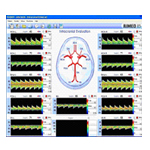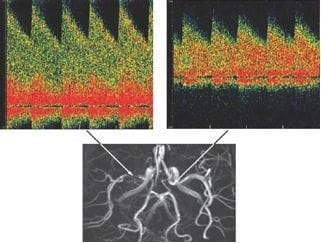
- #TRANSCRANIAL DOPPLER MACHINES TRIAL#
- #TRANSCRANIAL DOPPLER MACHINES SERIES#
- #TRANSCRANIAL DOPPLER MACHINES FREE#
#TRANSCRANIAL DOPPLER MACHINES FREE#
Microembolic signals in symptomatic carotid artery stenosis are associated with an increased risk of a recurrent ipsilateral focal ischaemia and and correlate with a greater number of magnetic resonance imaging detectable cerebral infarcts when compared with patients free from microembolism. Transcranial Doppler is a well established real-time imaging modality that evaluates cerebral blood flow velocity and detects microembolic signals in patients who suffer from cerebral or retinal ischaemia. The resulting thromboembolism can lead to a stroke or transient ischaemic attack (TIA).

Carotid atherosclerosis is a complex disease that is characterised by the deposition of luminal atheroma that may rupture, thrombose and embolise. Up to 25% of ischaemic strokes are caused by atherosclerosis of the internal carotid artery. Ischaemic stroke remains a major global cause of disability and death that is associated with an enormous social and economic burden.
#TRANSCRANIAL DOPPLER MACHINES TRIAL#
Trial registrationĬ (ID NCT 03050567), retrospectively registered on. However, larger studies are needed to validate its clinical applicability. Transcranial Doppler generates reproducible data regarding the middle cerebral artery velocities. No spontaneous embolisation was detected in either of the groups.

#TRANSCRANIAL DOPPLER MACHINES SERIES#
In both cohorts, the intra-observer Bland Altman analysis demonstrated acceptable mean measurement differences and limits of agreement between series of middle cerebral artery velocity measurements with very few outliers. Levels of agreement were assessed by interclass correlation co-efficient. In a quiet temperature-controlled room, two 1-h transcranial Doppler measurements of blood flow velocities and microembolic signals were performed sequentially on the same day (within-day repeatability) and a third 7–14 days later (between-day reproducibility). Methodsīetween March and August 2017, we recruited 20 healthy volunteers and 20 patients with symptomatic carotid artery stenosis. We here assessed the repeatability and reproducibility of transcranial Doppler ultrasound in healthy volunteers and patients with symptomatic carotid artery stenosis. Transcranial Doppler ultrasound remains the only imaging modality that is capable of real-time measurements of blood flow velocity and microembolic signals in the cerebral circulation.


 0 kommentar(er)
0 kommentar(er)
